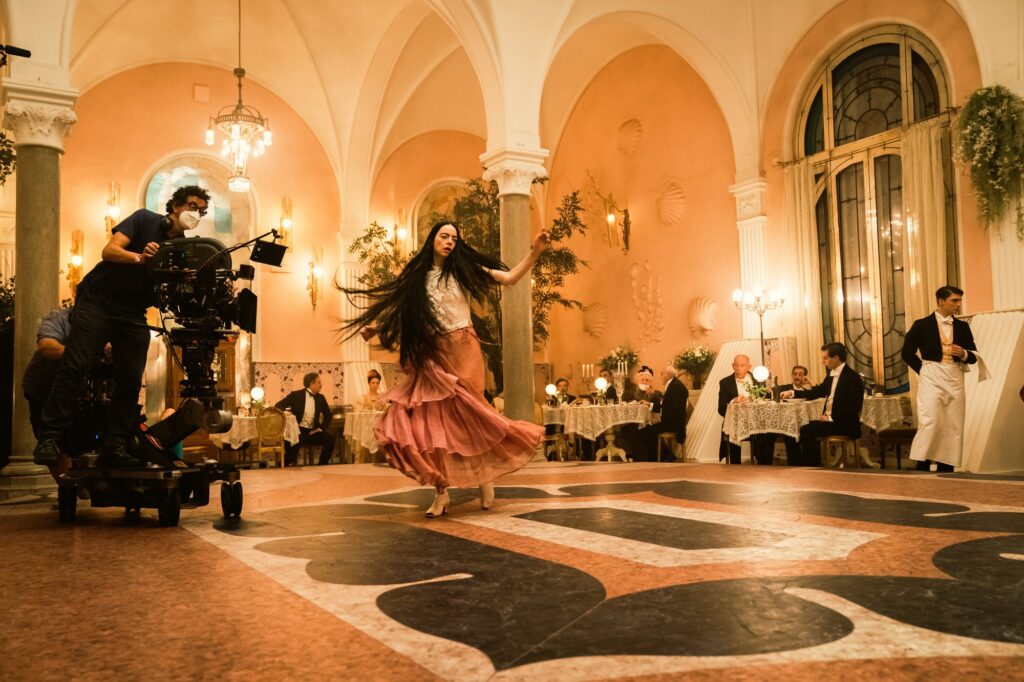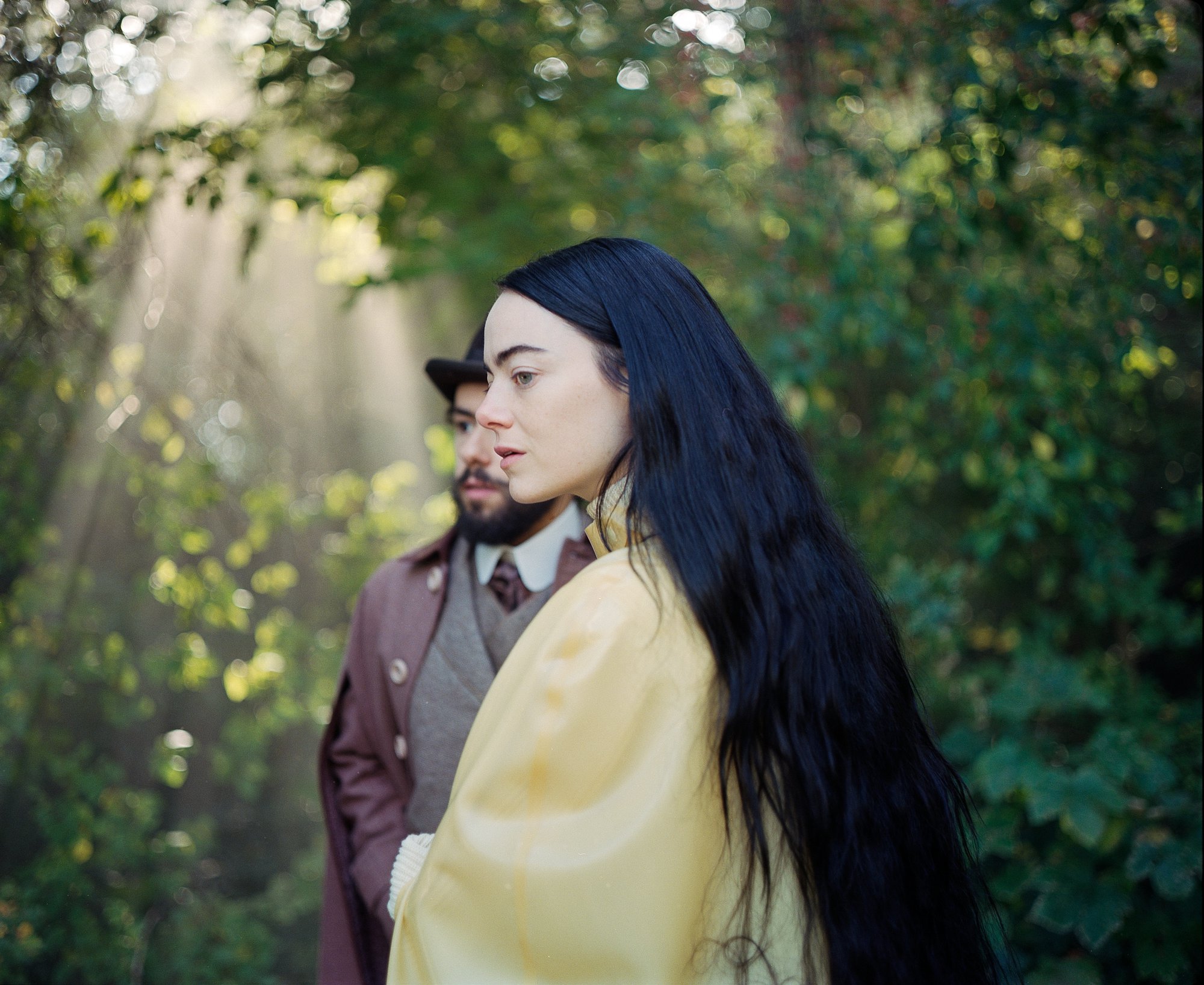Half a decade on from winning the Best Picture Oscar for The Favourite, director Yorgis Lanthimos has returned with Poor Things. Lanthimos’ eighth feature film reunites the Greek director with The Favourite actress Emma Stone. Poor Things premiered at Venice Film Festival in September, garnering significant critical claim ahead of the 2024 Awards season. Earlier this month, it won ‘Best Motion Picture – Musical or Comedy’ at the 81st Golden Globe Awards. Emma Stone also won ‘Best Actress – Musical or Comedy’ for her role in the film. Poor Things is also one of the frontrunners for a bevy of nominations at the 2024 Academy Awards. I had the opportunity to see the film on the closing night of the Belfast Film Festival in November. With Poor Things currently screening in cinemas across the UK/Ireland, I thought I would share my thoughts on the film.
Poor Things opens with a shot of an unknown young woman (Emma Stone) in a cerulean dress standing on the edge of London’s Tower Bridge. With a pained expression juxtaposed against the backdrop of a looming storm, she steps off the bridge and falls into the River Thames. The viewer catches up with our as-yet unnamed female protagonist a few minutes later, in the Victorian townhouse of Dr. Godwin Baxter (Willem Dafoe). Here we learn that this young woman is Bella Baxter, and she lives under the guardianship of the unorthodox Dr. Baxter, who Bella refers to as “God”.
Despite having the body on an adult, Bella lives an almost childlike existence. Initially Bella has limited communication skills (early in the film, Poor Things tells viewers her vocabulary expands by fifteen words a day). However it soon becomes clear Bella has an insatiable thirst for knowledge. Dr. Baxter eventually hires one of his research students – Max McCandles (Ramy Youssef) – to study Bella’s development. This leads to the revelation that Bella is not actually Godwin Baxter’s daughter. She is instead a Frankenstein-esque science experiment created by Godwin Baxter!
Max Candles’ presence at the Baxter household results in Bella’s development progressing at an accelerated pace. Her childlike curiosity and voracious appetite for knowledge leads to Bella’s grasp of language to grow exponentially. It also sees her experiencing a sexual awakening, after inadvertently discovering the pleasures of self-love. More importantly, Bella’s development sees her develop an interest in the world outside the confines of the Baxter mansion.
The arrival of the preening, caddish Duncan Wedderburn (Mark Ruffalo) provides Bella with a chance to flee her prison-like conditions. Wedderburn and Bella embark on a continent-spanning journey. This adventure sees the pair travel to Lisbon, before enjoying a luxury cruise to Athens via Alexandria. Their journey concludes with a stop in Paris, where Bella gains employment in a brothel. Each of these locales provides Bella with valuable life lessons. These include humanity’s cruelty to another, and self-improvement via eduction can be as liberating as sex.

The unquestionable star performance of Poor Things comes from its lead, Emma Stone. As Bella Baxter, Emma Stone delivers a pitch perfect performance that showcases her talent for physical comedy. This is most noticeable during the first two-thirds of the film where Bella’s motor skills are still developing. During these scenes, Emma Stone portrays Bella as almost like a new born foal or deer adjusting to their body. Bella’s movements are gangly-limbed and awkward, and look almost robotic.
The cartoonishly exaggerated motions Emma Stone utilises in her role as Bella are perhaps best demonstrated in a scene halfway through the movie. Bella and Wedderburn are staying in Lisbon at this time, and attend a hotel dinner party. Bored by the other guests at her table and with no prior experience of polite society, Bella’s instincts are to join the other guests dancing on the nearby ballroom floor. The choreography in this scene is terrific, with Stone awkwardly gliding across the dancefloor like a wind-up toy. Jerskin Fendrix’s slightly off-kilter, baroque score further enhances the mechanical qualities of the choreography of this dance sequence.
This awkwardness extends to Bella’s speech patterns, with Stone over-enunciating words. She also speaks with a distinctive speech pattern when describing things. This vocal tick sees Bella use an adjective to describe an object or experience, followed by two synonyms immediately afterwards. These exaggerated and robotic ticks to Bella’s character feel like an homage to Frankenstein’s monster, with Mary Shelley’s Frankenstein no doubt having been an inspiration to the original Poor Things novel.
While Emma Stone will justifiably get many of the plaudits for her performance in Poor Things, we should also give some credit to her male co-stars as well. Mark Ruffalo looks like he had a blast playing the vain Duncan Wedderburn. With his over the top reactions and constant playing to the camera, Mark Ruffalo’s Weddernburn is a constant source of entertainment. Ruffalo’s performance feels somewhat indebted to Terry Thomas, and he gets to deliver some of the film’s funniest lines.
Willem Dafoe meanwhile delivers a beautiful, albeit understated performance as Dr. Godwin Baxter. Sporting numerous scars across his body from experiments performed on him as a child by his surgeon father, Godwin Baxter could easily have been a cartoonish villain. Willem Dafoe instead brings a warmth to the character, and is a compassionate and understanding father figure to Bella. Ramy Youssef is also excellent if somewhat underutilised as Max Candles. Finally Christopher Abbot makes a lasting impression late on in Poor Things, in a small but crucial role.

While the performances of the Poor Things cast are outstanding across the board, the film is also a technical masterpiece. Director Yorgos Lanthimos’ utilises colour brilliantly in Poor Things, with the opening act having a monochrome colour palette. This along with cinematographer Robbie Ryan’s use of fisheye cameras creates a claustrophobic atmosphere that matches Bella feeling of imprisonment in the Baxter mansion. Once Bella gets to experience the world outside the mansion, the colour palette of Poor Thing shifts to dazzling technicolour.
The technique of shifting from monochrome to colour is a well established cinematic trope in 2024. But Poor Things makes it still feel relevant today. In particular the film’s use of overly-saturated blues and yellows when Bella first visits Lisbon lets viewers experience Bella’s sense of wonder and awe at the world around her for the first time. The use of these vibrant colours also gives the world Poor Things a surreal, hyper-realistic feel.
The production deign work of Shona Heath and James Price is stellar. The world that Poor Things takes place in has a clear steampunk aesthetic. This aesthetic is complemented by the costume designs of Holly Waddington, which are reminiscent of the 2010s video games series Bioshock. The steampunk aesthetic used in the film is best seen in two scenes. The first of these occurs early in the film when Dr Godwin Baxter takes Bella outside in a horse-drawn carriage. The carriage is pulled by horses, but there seems to be a steam engine at the rear of the carriage. The other scene that best demonstrates Poor Things incredible production design occurs when Bella is exploring Lisbon. In this scene, Bella looks up to the Lisbon skyline, and sees futuristic cable cars traversing the city as if they are hover cars.
The sheer amount of detail contained within the physical sets of Poor Things is incredible. Each of the film’s locales looks like a diorama model blown up to human proportions, and look absolutely stunning onscreen. Eagle-eyed viewers will no doubt discover new details built into these sets with subsequent rewatches. My personal favourite locale from a design perspective was the city of Alexandria. With its long, winding partially ruined staircase, it is where one of the most pivotal scenes in Poor Things take place.
Despite slightly overstaying its welcome, Poor Things is the first great film release of 2024. Visually stunning, and featuring incredible production design, Yorgos Lanthimos’ bold, feminist take on Frankenstein’s monster is a film that needs to be seen on the biggest screen possible. It also features three terrific performances from its central leads – Mark Ruffalo, Willem Dafoe, and of course Emma Stone. Emma Stone’s performance in particular is a mesmerising masterclass in physical comedy, and one that is rightly earning critical acclaim and awards nominations. So whatever you’re doing this weekend, make sure those plans include a trip to the cinema to see Poor Things!
